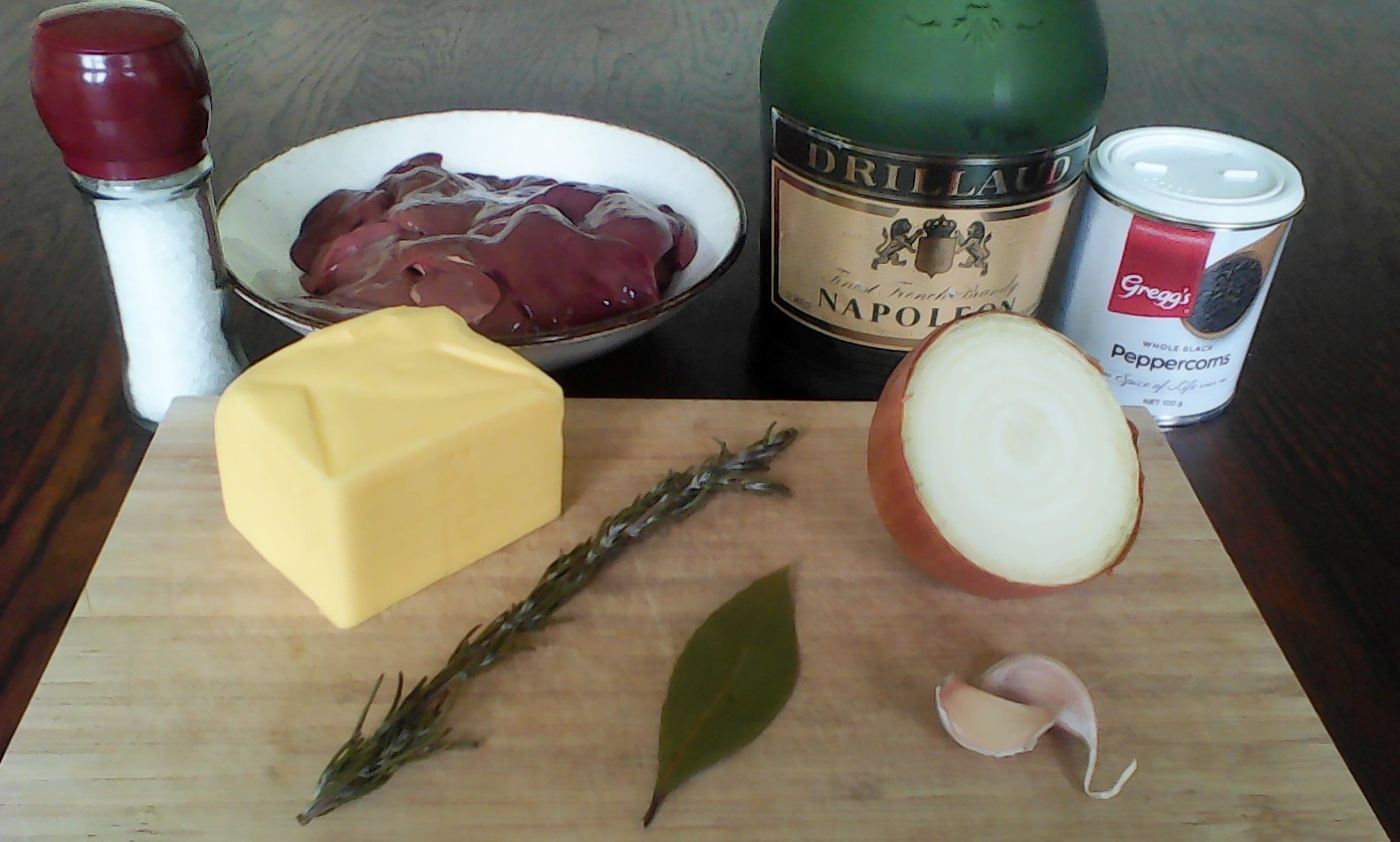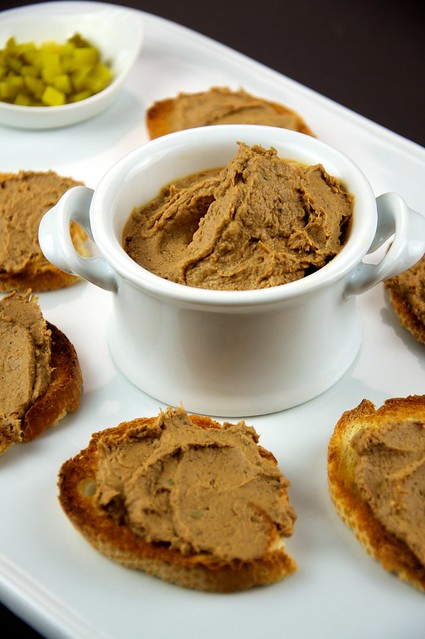Chickens are tough. Try eating a chicken’s foot, and you’ll really know what hardy means. One of the strongest bits of a chicken (in my entirely unscientific survey) is the liver, which is packed full of iron, i.e. what they make steel out of. Chickens are tough.

In a modern version of the ancient practice of eating someone or something to take on his, her, their or its qualities, I sometimes eat chicken livers, in an attempt to take on their iron levels. Liver tasting as it does, I eat it in the form of chicken liver pâté. And since the pâté in the shops is generally mostly made up of Things Which Are Not Chicken Livers, I have at last given in and started making my own. Bonus: it’s a lot cheaper than the commercial version and you can customize it to your taste. (Unless of course you are a vegetarian or vegan.)
You will need some chicken livers, about 400-500g (a pound-ish, imperialists); half an onion, chopped up small; two fat cloves of garlic, ditto; about 150g butter (say 5oz); 1/2 teaspoon salt; 1 or more teaspoons of peppercorns (depending on how much you don’t like the taste of liver); plenty of herbs (I used rosemary and a bay leaf, but sage and thyme are also suitable); and 2 tablespoons brandy – optional, but it does help disguise the liver taste. Port would also be good.

You will also need a frying pan and (alas!) a blender. It always used to peeve me when people offered “super-simple” recipes that required equipment I didn’t have, so my apologies if this won’t work for you. A hand-mincer and much stirring may yet do the job.
Melt 1/3 of the butter in the frying pan, and fry the onion and garlic until the onion looks fairly cooked. The bay leaf can go in here too, if you’re using one. While the onion fried, I used the blender to turn a teaspoon of peppercorns into pepper-dust (like watching a snow-globe full of midges), debated whether to add more pepper, and decided not to. I am still not sure this was the right decision, but after all, one can always add more pepper when one eats it.

Once the onion is cooked, you scoop it out of the pan (a slotted spoon is useful here) and put it aside, adding the livers to the pan in its place. Cook for about five minutes, until they look nice and brown. You can cut into a lobe to see if it’s cooked through: a bit pink in the middle is ok, but you don’t want it bleeding. (Helpful rule of life: if it’s bleeding, don’t eat it.)
When you are satisfied with the cookedness of the livers, plop them into the blender. Add the onion, being careful to remove the bay leaf first. Blend until no longer lumpy and then add the rest of the butter (goes in easier if it’s softened) and any herbs and spices you haven’t already added, along with the salt and the brandy (or port). Blend till smooth and creamy and then spoon into whatever container takes your fancy – bowls are nice for general presentation; jars are more practical if you’re not likely to eat it all at once.
Now, the traditional thing to do is to pour melted clarified butter over the top, and this is certainly of use if you are putting it away in ye olde cold stone pantry for some time. Personally, I don’t find a layer of yellowed fat on the top of my food to be very appetizing, so I leave that stage out. Chacun à son goût.
This is good in a sandwich with sliced tomatoes (with, of course, plenty of pepper) or spread on hot, hot toast – preferably Vogels. Crackers are another excellent form of pâté consumption, though I generally like something more on top. Again, tomato is good, as are cucumber and sometimes a little tasty cheese.

Having written this, I feel I would like to plead for a more rational spelling of pâté, which just says “French was here.” Maybe not pate (that one is already taken, and eating the tops of people’s heads is frowned on, provident Fejee or not), but something. Partay? Putty? I remember from my brief career as a French student that the circumflex – on the â – often means there used to be an s in there, which English has usually kept. Pâté = paste. Would pâté de foie gras be as popular if it was advertised as “fat liver paste”? I think not.

Thanks for sharing the recipe! I look forward to trying some 🙂
Plenty to go round!